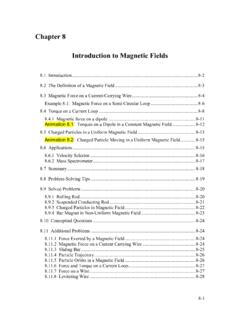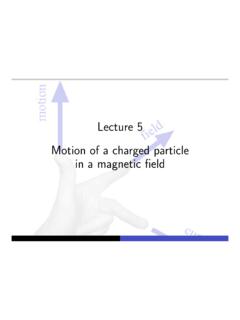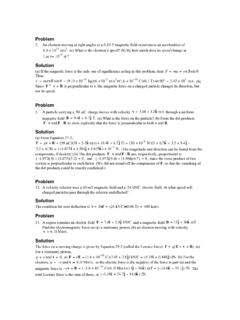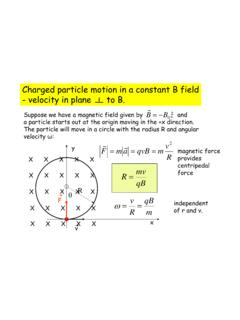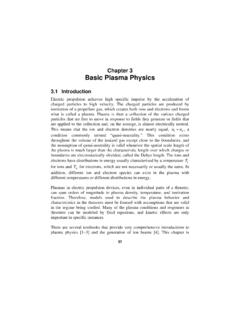Transcription of Synchrotron Radiation - NASA
1 Synchrotron RadiationThe Synchrotron Radiation , the emission of very relativistic and ultrarelativisticelectrons gyrating in a magnetic field, is the process which dominates much of highenergy astrophysics. It was originally observed in early betatron experiments inwhich electrons were first accelerated to ultrarelativistic energies. This process isresponsible for the radio emission from the Galaxy, from supernova remnants andextragalactic radio sources. It is also responsible for the non-thermal optical andX-ray emission observed in the Crab Nebula and possibly for the optical and X-raycontinuum emission of wordnon-thermalis used frequently in high energy astrophysics to describe theemission of high energy particles. This an unfortunate terminology since allemission mechanisms are thermal in some sense. The word is conventionallytaken to mean continuum Radiation from particles, the energy spectrum of which isnot Maxwellian.
2 In practice, continuum emission is often referred to as non-thermal if it cannot be described by the spectrum of thermal bremsstrahlung or of an Electron in a Uniform, StaticMagnetic fieldWe begin by writing down the equation of motion for a particle of rest massm0,chargezeand Lorentz factor = (1 v2/c2) 1/2in a uniform static ( m0v) =ze(v B)(1)We recall that the left-hand side of this equation can be expanded as follows:m0ddt( v) =m0 dvdt+m0 3v(v a)c2(2)because the Lorentz factor should be written = (1 v v/c2) 1/2. In amagnetic field, the three-accelerationa= dv/dtis always perpendicular tovandconsequentlyv a= 0. As a result, m0dv/dt=ze(v B)(3)2 Motion of an Electron in a Uniform, StaticMagnetic fieldWe now splitvinto components paralleland perpendicular to the uniformmagnetic field,v andv pitch angle of the particle s path isgiven bytan =v /v , that is, is theangle between the B= 0,v =constant.
3 Theacceleration is perpendicular to themagnetic field direction and tov . m0dvdt=zev B(i iB) =zevB(iv iB)(4)whereivandiBare unit vectors in thedirections , the motion of the particle consists of a constant velocity along the magneticfield direction and circular motion with radiusrabout it. This means that the particlemoves in aspiral pathwithconstant pitch angle . The radiusris known as thegyroradiusof the particle. The angular frequency of the particle in its orbit gisknown as theangular cyclotron frequencyorangular gyrofrequencyand is given by g=v /r=zeB/ m0(5)The correspondinggyrofrequency g, that is, the number of times per second thatthe particle rotates about the magnetic field direction, is g= g/2 =zeB/2 m0(6)In the case of a non-relativistic particle, = 1and hence g=zeB/2 useful figure to remember is the non-relativistic gyrofrequency of an electron g=eB/2 me= 28 GHz T 1where the magnetic field strength is measured intesla; alternatively, g= G 1for those not yet converted from gauss (G)to teslas (T).
4 4 The Total Energy Loss RateMost of the essential tools needed in this analysis havealready been derived. First of all, use the expression forthe acceleration of the electron in its orbit and insert thisinto the expression for the Radiation rate of a relativisticelectron. The acceleration is always perpendicular to thevelocity vector of the particle and toBand hencea = , the total Radiation loss rate of the electron is (dEdt)= 4e26 0c3|a |2= 4e26 0c3e2v2B2sin2 2m2e(7)=e4B26 0cm2ev2c2 2sin2 (8)5 The Total Energy Loss Rate - Another ApproachLet us start from the fact that in the instantaneous rest frameof the electron, the acceleration of the particle is small and sowe can use the non-relativistic expression for the radiationrate. The instantaneous direction of motion of the electron inthe laboratory frame, the frame in whichBis fixed, is takenas the positivex-axis.
5 We now transform the field quantitiesinto the instantaneous rest frame of the electron. InS , theforce on the electron isf =me v =e(E +v B ) =eE (9)since the particle is instantaneously at rest inS . Therefore,in transformingBintoS , we need only consider thetransformed components for the electric fieldE .E x=ExE x= 0E y= (Ey vBz)and soE y= v Bz= v Bsin E z= (Ez+vBy)E z= 06 Therefore v = e vBsin me(10)Consequently, in the rest frame of the electron, the loss rate by Radiation is (dEdt) =e2| v |26 0c3=e4 2B2v2sin2 6 0c3m2e(11)Since (dE/dt) is a Lorentz invariant, we recover the formula (8). Recalling thatc2= ( 0 0) 1, let us rewrite this in the following way (dEdt)= 2(e46 20c4m2e)(vc)2cB22 0 2sin2 (12)The quantity in the first set of round brackets on the right-hand side of (8) is theThomson cross-section T. Therefore (dEdt)= 2 TcUmag(vc)2 2sin2 (13)whereUmag=B2/2 0is the energy density of the magnetic Average Energy Loss RateIn the ultrarelativistic limit,v c, we may approximate this result by (dEdt)= 2 TcUmag 2sin2 (14)These results apply for electrons of a specific pitch angle.
6 Particles of a particularenergyE, or Lorentz factor , are often expected to have an isotropic distribution ofpitch angles and therefore we can work out their average energy loss rate byaveraging over such a distribution of pitch anglesp( )d =12sin d (dEdt)= 2 TcUmag 2(vc)212 0sin3 d =43 TcUmag(vc)2 2(15)There is a deeper sense in which (15) is the average loss rate for a particle of energyE. During its lifetime, it is likely that the high energy particle is randomly scattered inpitch angle and then (15) is the correct expression for its average energy loss gyroradiation and cyclotron radiationConsider first the simplest case of non-relativistic gyroradiation, in which casev cand hence = 1. Then, the expression for the loss rate of the electron is (dEdt)= 2 TcUmag(vc)2sin2 =2 TcUmagv2 (16)and the Radiation is emitted at the gyrofrequency of the electron g=eB/2 the non-relativistic case, there are no beaming effects and the polarisationobserved by the distant observer can be derived from the rules given above.
7 Whenthe magnetic field is perpendicular to the line of sight,linearly polarised radiationisobserved because the acceleration vector is observed to perform simple harmonicmotion in a plane perpendicular to the magnetic field by the distant observer. Theelectric field strength varies sinusoidally at the gyrofrequency. When the magneticfield is parallel to the line of sight, the acceleration vector is continually changingdirection as the electron moves in a circular orbit about the magnetic field lines andtherefore the Radiation is observed to be 100%circularly polarised. Between thesecases, the Radiation is observed to beelliptically polarised, the ratio of axes of thepolarisation ellipse beingcos .9 Mildly Relativistic Cyclotron RadiationEven for slowly moving electrons,v c, not all the Radiation is emitted at thegyrofrequency because there are small aberration effects which slightly distort thepolar diagram from acos law.
8 From the symmetry of these aberrations, theobserved polar diagram of the Radiation can be decomposed by Fourier analysis intoa sum of equivalent dipoles radiating at harmonics of the relativistic gyrofrequency rwhere r= g/ . These harmonics have frequencies l=l r/(1 v ccos )(17)whereltakes integral values,l= 1,2,3,.. and the fundamental gyrofrequency hasl= 1. The factor[1 (v /c)cos ]in the denominator takes account of theDoppler shift of the Radiation of the electron due to its translational velocity along thefield lines, projected onto the line of sight to the observer,v . In the limitlv/c 1, itcan be shown that the total power emitted in a given harmonic for the casev = 0is (dEdt)l=2 e2 2g 0c(l+ 1)l2l+1(2l+ 1)!(vc)2(18)10 Mildly Relativistic Cyclotron RadiationHence, to order of magnitude,(dEdt)l+1/(dEdt)l (vc)2(19)Thus, the energy radiated in high harmonics is small when the particle the particle becomes significantly relativistic,v/c , the energy radiatedin the higher harmonics becomes important.
9 The Doppler corrections to theobserved frequency of the emitted Radiation become significant and a wide spreadof emitted frequencies is associated with the different pitch angles of an electron ofenergyE= mc2. The result is broadening of the width of the emission line of agiven harmonic and, for high harmonics, the lines are so broadened that theemission spectrum becomes continuous rather than consisting of a series ofharmonics at well defined Relativistic Cyclotron RadiationThe results of calculations for arelativistic plasma havingkTe/mec2= , corresponding to = , are shown inthe diagram. The spectra of the firsttwenty harmonics are shown as well asthe total emission spectrum found bysumming the spectra of the individualharmonics. One way of looking atsynchrotron Radiation is to consider it asthe relativistic limit of the processillustrated in the diagram in which all theharmonics are washed out and asmooth continuum spectrum Relativistic Cyclotron AbsorptionA remarkable example of the application ofthese formulae in absorption occurred in thetransient X-ray pulsar V0332+53 observed bythe INTEGRAL and RXTE satellites.
10 The sourceexhibited a very powerful outburst in Dec, 2004 Feb, 2005 in a wide (3-100 keV) energy cyclotron resonance scattering line at anenergy of 26 keV was detected together with itstwo higher harmonics at 50 and 73 keV,respectively (Tsygankov, Lutovinov, Churazovand Sunyaev 2005).13 Cyclotron Emission in AM Herculis BinariesThe harmonics of cyclotron Radiation are circularly polarised and so it is possible tolearn a great deal about the strength of the magnetic field strength and itsorientation with respect to the line of sight. Circularly polarised optical emission hasbeen discovered in the eclipsing magnetic binary stars known asAM Herculisbinaries, in which a red dwarf star orbits a white dwarf. Circular polarisationpercentages as large as 40% is observed. Accretion of matter from the surface ofthe red dwarf onto the magnetic poles of the white dwarf heats the matter totemperatures in excess of107K.

